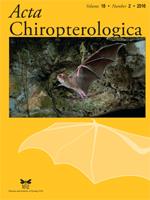Folivory can be defined as the consumption of foliage, including leaves, stems and leaf content. This trophic strategy has been documented in two families of bats, Pteropodidae (Old World fruit bats) and Phyllostomidae (New World leaf-nosed bats). Existing folivory hypotheses for bats suggest this behavior provides a dietary supplement of protein and other essential minerals due to a deficiency of these in a frugivorous diet. The Caatinga is a seasonally deciduous tropical dry forest where most of the vegetation is leafless and dormant during the extended dry season. Here we present the first evidence of folivory in bats from the Brazilian Caatinga, with evidence for the phyllostomid Artibeus planirostris ingesting the leaves of at least 16 species of plants. We include a bibliographic review of bat folivory in the tropics. Additionally, we propose a new hypothesis on folivory in bats for this semiarid environment.
How to translate text using browser tools
1 December 2016
Are Leaves a Good Option in Caatinga's Menu? First Record of Folivory in Artibeus planirostris (Phyllostomidae) in the Semiarid Forest, Brazil
Eugenia Cordero-Schmidt,
Maricélio Medeiros-Guimarães,
Juan Carlos Vargas-Mena,
Bruna Carvalho,
Rodrigo Lopes Ferreira,
Bernal Rodriguez-Herrera,
Eduardo M. Venticinque
ACCESS THE FULL ARTICLE

Acta Chiropterologica
Vol. 18 • No. 2
December 2016
Vol. 18 • No. 2
December 2016
Caatinga
caves
Feeding habits
folivory
Phyllostomidae
Pteropodidae




